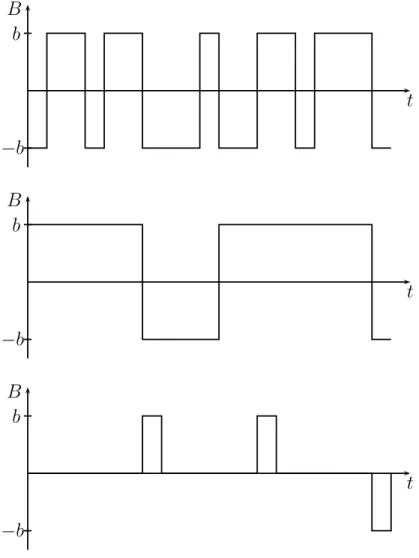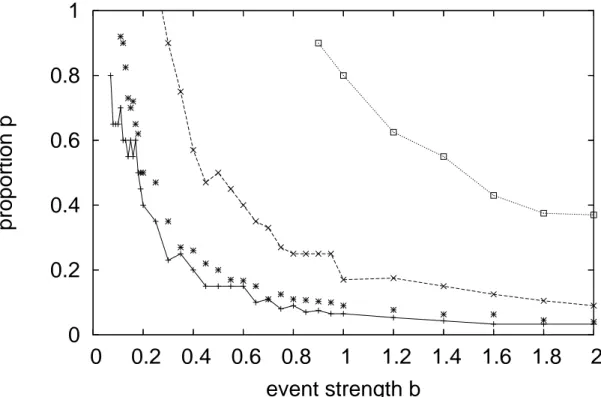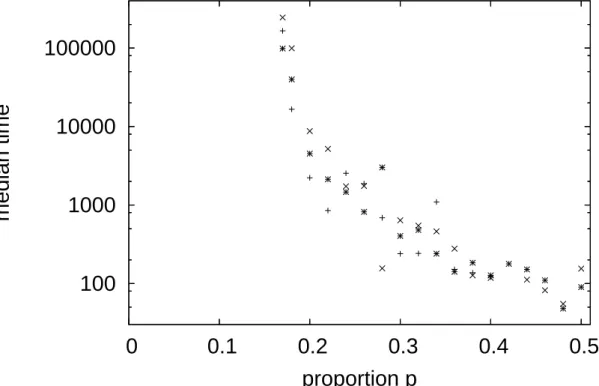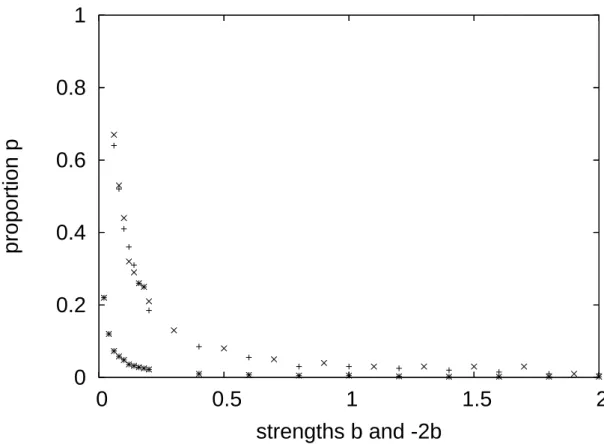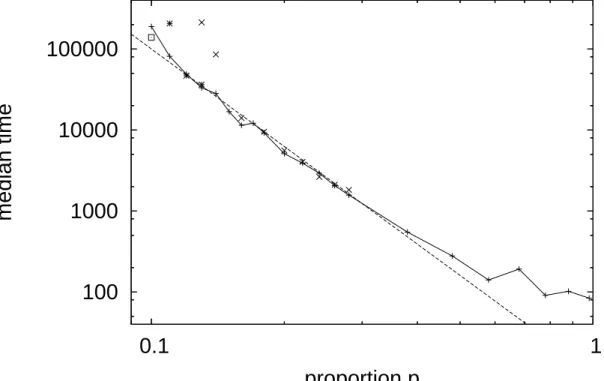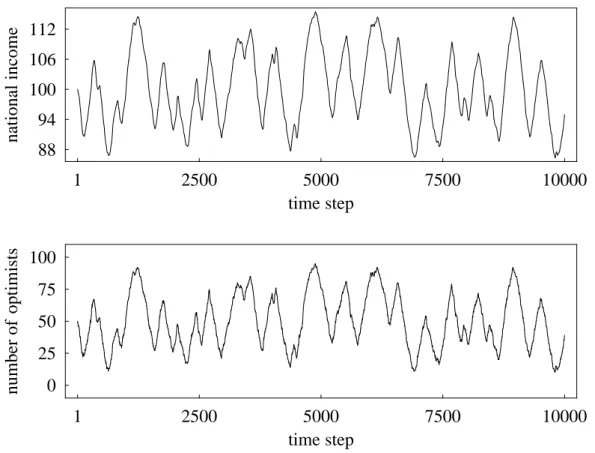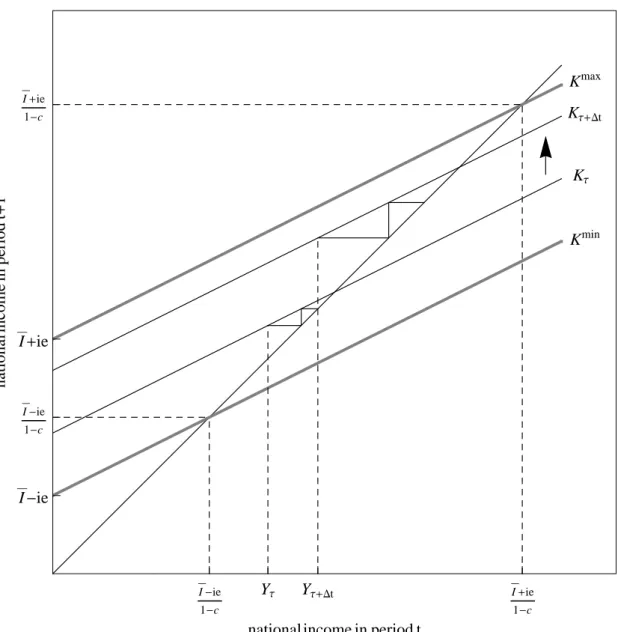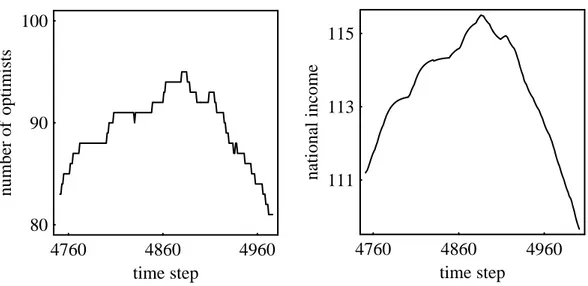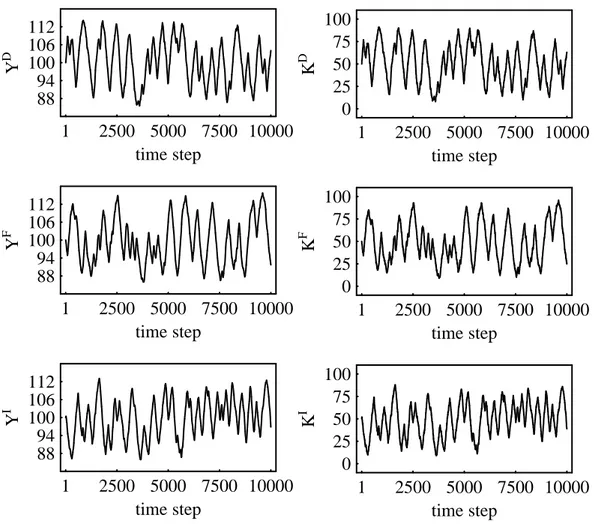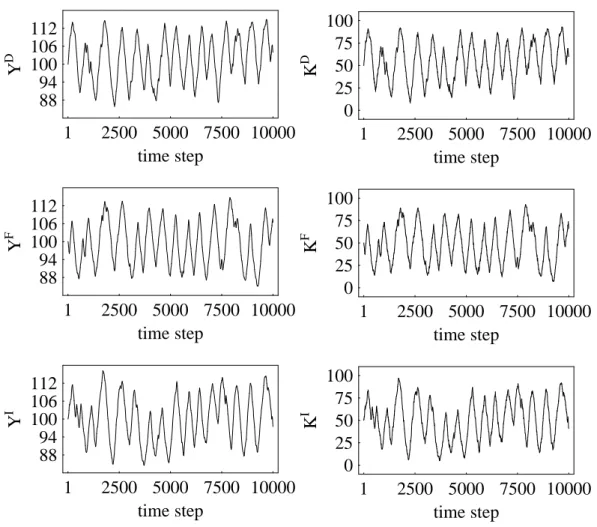Models of direct-interactions-driven collective economic phenomena
Dissertation
zur Erlangung des akademischen Grades Doctor rerum politicarum (Dr. rer. pol.)
vorgelegt der Sozial- und Wirtschaftswissenschaftlichen Fakult¨ at der Otto-Friedrich-Universit¨ at Bamberg
von Martin Hohnisch
1. Gutachter: Prof. Dr. Frank Westerhoff 2. Gutachter: Prof. Dr. Dietrich Stauffer
Tag der m¨undlichen Pr¨ufung: 30. Oktober 2007
CONTENTS
Introduction and Overview Papers:
1.* M. Hohnisch, S. Pittnauer, S. Solomon and D. Stauffer: Socioeconomic interaction and swings in business confidence indicators - Physica A: Statistical Mechanics and its Applications 345, 2005.
2. M. Hohnisch, D. Stauffer and S. Pittnauer: The Impact of External Events on the Emergence of Collective States of Economic Sentiment.
3.* T. Erez, M. Hohnisch and S. Solomon: Statistical Economics on Multi-Variable Layered Networks, in: Economics: Complex Windows, ed. M. Salzano and A.
Kirman, Springer, 2005.
4.* F. Westerhoff and M.Hohnisch: A note on interactions-driven business cycles, Journal of Economic Interaction and Coordination 2(1), 2007.
5. M. Hohnisch and F. Westerhoff: Business cycle synchronization in a simple Keynesian macro model with socially-transmitted economic sentiment and international sentiment spill-over.
6. M. Hohnisch: Local-Interactions-Based Coordination of Equilibrium Expectations and the Emergence of Sunspot Equilibria.
7. M. Hohnisch, S. Pittnauer and D. Stauffer: A Percolation-Based Model Explaining Delayed Take-Off in New-Product Diffusion.
The papers marked by * are not included in the electronic document.
Introduction and Overview
The present thesis consists of seven papers specifying and analysing models of direct-interactions-driven collective economic phenomena. Within theories and models of coordination in large decentralised market economies (and analogously also within theories and models of coordination in natural systems, for instance models of magnetism) the notion ofdirect interactionsis to be contrasted with the notion of indirect interaction via aggregate signals, such as the price system. The latter notion has been at the core of the Walrasian concept of decentralised eco- nomic coordination (see Walras (1898)) which developed into the Arrow-Debreu formulation of General Equilibrium Theory (see Debreu (1959) and Arrow and Hahn (1969)). Unlike indirect interactions – for which realistic micro-foundations (for instance, how a macroscopic signal emerges in a decentralised way) are ab- sent in the Arrow-Debreu model and related models – direct interactions between individuals are a straightforwardly realistic notion: they correspond to our daily experience of social life, affecting attitudes, opinions, beliefs and decisions in all ar- eas of life. Yet despite its intuitive appeal, the consideration of direct interactions is a relatively new development in large-system coordination models in econom- ics, with its roots going back to F¨ollmer (1974).1 Blume and Durlauf define the (direct) interactions-based approach as one “focusing on direct interdependencies between economic actors rather than those indirect interdependencies that arise through the joint participation of economic agents in a set of markets” (Blume and Durlauf, 2001, p.16).2
1The literature on direct-interactions based phenomena includes Bisin et al. (2006), Blume (1993, 1995), Cont and Bouchaud (2000), Horst and Scheinkman (2006), Kim and Markowitz (1989), Kirman (1991, 1993), Levy et al. (1994) and Lux (1995). For a recent overview of interactions-based models of financial markets, see Samanidou et al. (2007). Interactions-based models are also oftencalled agent-based models.
2It should be noted that strategic interactions which are modelled in Game Theory in many
One can distinguish two polar types of direct-interactions models: those with a fixed topology of interactions and those with random matching. In models with a fixed topology, a graph represents the structure of inter-agent influence or com- munication channels. Any given agent always interacts with the same subset of other agents (called his local neighbourhood) - consisting of those agents to whom a direct link exists.3 As a result, for any particular specification of variables as- sociated with the agents the macroscopic properties of the system (obtained from averaging over large subsets of these variables) might look quite different in dif- ferent “areas” of the graph, at least temporarily. In contrast, in random matching models for each instance of an interaction the two agents interacting are selected randomly from the entire population of agents. Thereby the probability to be matched with a certain type of agent corresponds to the empirical distribution of types in the entire population. As a result, no “spatial” patterns emerge in such models, and an approximation by indirect-interaction models becomes cor- rect. Clearly, real-world matching schemes feature aspects of both of the above polar cases: interaction partners are neither fixed, nor is it the case that they are completely random, as past partners and future partners are in many cases not independent.4 In the present thesis, Papers 4 and 5 are random matching models, whereas all other papers involve a fixed topology.
An important conceptual issue by which many direct-interaction large-economy models differ from the neo-classical modelling tradition is the following: Rather than modelling individual decisions according to the economic concepts of rational- ity – such that these decisions obtain endogenously in the model – large-economy models with direct interactions are in many cases phenomenological on the indi- vidual level. That is to say, some basic tendency driving the interactions between agents, for instance the tendency to conform with others, is not derived from a ra- tionality conceptwithin the model (in other words, it is exogenous to the model).
Instead, a behavioural pattern is introduced based on empirical knowledge by specifying appropriate stochastic transition kernels which produce the observed
3More generally, interactions of decreasing strength can be defined for those agents who are
“farther away” (i.e. who can be reached via two links, three links etc.
statistical regularity in large samples of individual agents.5 But it is important to keep in mind that the stochastic specification does not represent intrinsic ran- domness in individual behaviour but rather outside effects not considered in the model.
Let us now turn to the second main notion emphasised in the title of the thesis, namely the notion of collective phenomena. Loosely speaking, a collective phenomenon is one in which the macroscopic properties of the system in no way mirror the individual behaviour of the system. Rather, they emerge from the interactions between the constituents. In contrast, in much of the neo-classical modelling of large economies, a single “representative” agent allegedly representing an entire sector of the economy is assumed (for a critique of this concept, see Kirman (1992)). Thereby, the distinction between the micro-variables and macro- variables of a system is effectively destroyed.
A reason for the prevalence of the representative-agent approach in neo-classical economics is the complexity of the endogenous, rationality-based modelling of indi- vidual decisions, which would lead in many cases to insurmountable computational difficulties in models with many heterogeneous agents. Recently, however, mod- els with many heterogeneous agents which are “simple” at the individual level and which aim at collective phenomena have become increasingly popular among economists (see, for instance, Galegatti and Kirman (1999)). This due to two factors: first, the emerging strong evidence of the crucial role of heterogeneity in modelling economic systems coming from empirical research, and, second, re- sults of experimental research in economics pointing to the conclusion that the rationality-based approach to individual decision making is insufficient or posi- tively wrong (see, for instance, Selten (2001)).
Let us now turn to the methods of analysis of stochastic models of multi- component (multi-agent) systems with direct interactions. In a few exceptional cases, analytical techniques developed in mathematical physics are available, which are applicable also to models of very large systems (these are models with an infinite number of agents). Still, analytical techniques typically yield results of a
5In papers 1-6 the specification of interactions are such that agents tend to conform to the expectations of others. There exists ample evidence that agents do so (see, for instance, Asch (1951, 1956) and Festinger (1956)). The neo-classical tradition would require that this type of
principle nature (existence of an equilibrium measure, conditions for its uniqueness vs. non-uniqueness etc.). As an alternative, Monte-Carlo techniques have become widespread in the investigation of stochastic interactions-driven models. Monte Carlo simulations readily provide a clear picture of the typical behaviour of models with a finite set of agents.6 In the present thesis, all papers except Paper 6 feature Monte-Carlo results of models with a finite set of agents.
In the remainder of this introductory chapter, an overview of the papers con- stituting the present thesis is given. Except Paper 7, in all papers of the present thesis direct interactions affect individual expectations of agents. Traditionally, expectations are modelled as autonomous, either rational – implying that they are defined as being correct rather than emerging from certain cognitive procedures – or derived by an individual agent by sampling the path of macroscopic variables and forming adaptive, extrapolative or other types of expectations. However, there is well-established empirical evidence from social psychology that expecta- tions – just as any other type of individual judgements – are, at least to some degree, affected by interactions among human beings. The papers 1-6 of this the- sis demonstrate how interdependent expectations can shed new light on various economic phenomena.
In particular, Part 1 of the thesis, consisting of Papers 1 and 2, features two models of an interactive dynamics of economic sentiment in which no link between economic sentiment and real economic variables is established. Such an approach is admissible if one can neglect feedbacks from the real economic variables to eco- nomic sentiment, such that the dynamics of economic sentiment can be modelled separately from that of real economic variables. In these two models, economic sentiment of a certain individual is affected by the consumer sentiment of others and possibly by exogenous macroscopic shocks of an economic, social or political nature. Each paper of Part 2 of the thesis – consisting of Papers 3, 4, 5 and 6 – does establish a link between the interactive sentiment dynamics and real economic variables. This link can be provided in various economic frameworks determining real economic variables. In particular, Papers 4 and 5 are in the context of the
6Moreover, concepts have been developed how to generalise results by induction from finite models to infinite models (this approach is called Thermodynamic Limit in Physics). However, in economic applications the extension of results to infinite systems is often not desired, as the
standard Keynesian multiplier macro-model of consumption, output and saving, while Paper 6 is in the context of General Equilibrium Theory. Paper 3 features a model of precautionary saving which can be integrated within Keynesian, Gen- eral Equilibrium and other models. By considering feedbacks from real economic variables to economic sentiment, these papers integrate the notion of interactively- driven consumer sentiment within a complete economic model framework, being a quite new theoretical development. Finally, Part 3containing Paper 7, addresses the issue of new-product diffusion. In that context, direct interactions trigger the formation of individual valuations for a new product. This part demonstrates the flexibility of the stochastic interactions-based approach by showing that phe- nomenologically quite different phenomena can by explained in an essentially same conceptual approach to modelling interactions.
In the following, a brief summary of each of the seven papers is given. Paper 1, titledSocioeconomic interaction and swings in business confidence in- dicators (being a joint paper with S. Pittnauer, S. Solomon and D. Stauffer)7 is motivated by certain patterns in the German Ifo-Index data which were first inves- tigated from the perspective of collective phenomena by Flieth and Foster (2002).
To account for such patterns in our paper, collective economic sentiment formation is modelled as emerging from direct interaction between managers within an indus- try. The neighbourhood structure of managers is assumed to be fixed (each agent interacts with the same four neighbours over the entire time horizon). Following the structure of the Ifo-survey, each manager can have three opinions: optimistic, pessimistic or neutral. Each manager tends to conform with the opinions prevalent in his/her reference group, with the strength of the tendency being different for different types of opinion. The main result of the paper is the appearance of large abrupt swings in the mean consumer sentiment. This phenomenon is well-known in the study of collective phenomena in physics. It corresponds to the appearance of spontaneous changes of the phase of the Ising model or the Blume-Capel model of ferro-magnetism.
Paper 2, titled The impact of external events on the emergence of so- cial herding of consumer sentiment, (which is a joint paper with S. Pittnauer and D. Stauffer) incorporates the impact of external events on the dynamics of
economic sentiment in a model very similar to that featured in Paper 1. A direct- interactions-driven dynamics of economic sentiment is represented by an Ising model on a large (two-dimensional) square lattice. The individual states of agents are called optimism and pessimism. The exogenous environment is modelled as a sequence of random events, which might have a positive or negative influence on economic sentiment. These exogenous events can be frequent or rare, have a lasting impact or a non-lasting impact. Impact of events is inhomogeneous over the lattice, as individuals might fail to perceive particular events. Events have a probabilistic relation with the state of each individual agent – technically specified in the same manner as the impact of states of neighbouring agents. The aim of the paper is to investigate the effect of an exogenous environment on the emer- gence of social herding of economic sentiment. We introduce two notions of social herding: permanent herding refers to the situation where an ordered state (i.e.
a state with an overwhelming majority of optimists or pessimists) persists over an infinite time horizon, while temporary herding refers to the situation where ordered states appear, persist for some time and decay. The parameter of the inter-agent interaction strength is such as to engender permanent herding without the influence of the environment. We consider two cases: in the first case positive and negative events have both the same empirical frequencies and strengths (i.e.
the environment is “neutral” in the long term), while in the second case events have the same empirical frequencies but different strengths. In the neutral case we find temporary herding if events are sufficiently “strong” and/or perceived by a sufficiently large proportion of agents, and our results suggest that permanent herding occurs for small values of the parameters. In the “non-neutral” case we find only temporary herding.
Paper 3, titled Statistical economics on multi-variable layered net- works (which is a joint paper with T. Erez and S. Solomon)8 extends the frame- work of the above two papers by incorporating individual saving rate as a second type of individual variable. In our model, the individual sentiment variables can assume two values (optimism, pessimism), while the saving variables can assume any of the Q budget shares Q1,Q2, . . . ,Q−1Q ,1. The topology of interactions is that
8This paper has been published in the edited volume Economics: Complex Windows, ed.
of a (large but finite) one-dimensional lattice with respect to each of the variable types. Using the statistical approach, we introduce the regularity that an agent who is optimistic about the prospects of the economy is likely to save more than a pessimistic agent.
In addition to the economic issues just discussed, the paper makes the fol- lowing contribution to the general issue on network architectures: Since the local neighbourhood of each agent related to each of his/her individual variables need not be identical (agents who influence an agent’s economic sentiment might not be the same as those who influence his saving), agents are effectively linked in a more complex way than what would be the case without the linkage between individual saving and economic sentiment. A network structure representing that situation (which arises quite naturally whenever an agent is characterised by more than one interdependent variables) is sometimes called a Solomon-Network. Along with Malarz (2003), the paper is one of the first to define and analyse stochastic models on such network structures (see also Billari et al. (2006) for additional motivation to consider such network structures in modelling socio-economic sys- tems).
Paper 4, titledA note on interactions-driven business cycles (which is a joint paper with F. Westerhoff)9explores the impact of an interactive dynamics of economic sentiment on real economic variables in the standard Keynesian multi- plier framework. Unlike in the above Papers 1-3, the interactions are direct but not local (random matching). That is to say, each consumer meets another consumer at random, independently of whom he/she met before or what his/her individual variable values are. The underlying micro-model of direct interactions is a version of Kirman’s (1993) generic opinion formation model, with an additional feedback effect from macroscopic variables on the transition probabilities. As in the above model, pessimism (optimism) is assumed to engender higher (lower) saving. Our model engenders cyclical fluctuations of economic variables, despite the fact that neither the Keynesian multiplier model nor Kirman’s model does so on its own.
Paper 5, titled Business cycle synchronisation in a simple Keynesian model with socially-transmitted economic sentiment and international sentiment spill-overs (which is a joint paper with F. Westerhoff) is based on
the Keynesian multiplicator-accelerator model (see Samuelson 1939) with the novel feature that national income expectations affect investment and drive the Samuel- sonian accelerator dynamics (see Westerhoff 2006). The role of the interactive sen- timent dynamics is the same as in the previous paper, while the influence channel of economic sentiment is complementary: it is assumed that investors who hold optimistic views about the future state of the economy expect a higher aggregate demand in the following period and thus invest more than pessimistic ones. Sim- ulations show that the model can generate a complex business cycle dynamics.
Based on that framework, a three-country model of business cycle synchronisa- tion is provided, in which international spill-over effects on the level of economic sentiment synchronise the national cycles, provided that investors believe that the economies are indeed coupled.
Paper 6, titled Local-interactions-based coordination of equilibrium expectations and the emergence of sunspot equilibria10 differs from all other papers of the thesis in several respects: it features a model with an infinite number of agents (representing the dynamics of a very large system), it investigates the model analytically (using well-known results in Probability Theory) and it is set in the context of General Equilibrium Theory.11 As all of the previous papers, it introduces a stochastic direct-interactions-based dynamics of agents’
expectations. Unlike in the previous papers, the expectations refer to different Walrasian equilibria which can prevail in the model economy in a future point in time. The paper demonstrates that the stochastic direct-interactions-based dynamics can explain how in General Equilibrium Theory one equilibrium (out of multiple) can be decentrally agreed upon. Moreover the model naturally engenders coordination into sunspot equilibria (with the sunspot events endogenously arising in the coordination process).12
10A previous version is available online asBonn Econ Discussion Paper2005/23
11For those who are sceptical about the positive content of the assumptions underlying General Equilibrium Theory, such as market clearing, one could perceive the paper as apply- ing a direct-interactions mechanism to General Equilibrium Theory to alleviate some inherent problems of it rather than to positive modelling.
12A sunspot-equilibrium in General Equilibrium models is one in which a random event with no a-priori effect on the economy (calledsunspot) nevertheless affects the economy because
The particular specification of transition rates chosen in the present paper is known as the (two-dimensional) Voter Model. The composite process has two ex- tremal invariant measures and a continuum of non-extremal invariant measures, to each of which it can converge. Convergence to either one of the extremal invariant measures corresponds to a deterministic coordination outcome, selecting a non- sunspot equilibrium of the underlying economy. Convergence to a convex mixture of invariant measures corresponds to a fully coordinated but random coordina- tion outcome of individual expectations. The latter has precisely the structure of equilibrium expectations in a sunspot equilibrium, and it is the uncertainty of the coordination outcome which determines the set of sunspot equilibria of the underlying economy. In effect, it is the non-ergodicity of the coordination process which facilitates the occurrence of sunspot equilibria in the proposed model.
In the final Paper 7, titled Explaining delayed take-off in new-product diffusion (which is a joint paper with S. Pittnauer and D. Stauffer)13 direct in- teractions affect a quite different type of variable as compared to the previous six papers. Instead of economic expectations, it is now the formation of the individual valuation of a new product which is triggered by local direct interactions between consumers: it is only upon the observation of a neighbour’s usage of a product that a consumer forms the valuation of the product. In that model – despite the formation of the valuation being triggered by the neighbours – the valuations themselves are stochastically independent among agents. A consumer buys the new product if her valuation of it is not below the price of the product in a given period. From a technical perspective, the dynamics of the model amounts to a stochastic process which is well-known in physics as site-percolation dynamics.14 It is known that there exists a real number called the percolation threshold Pc which constitutes a value for the “transmission probability” above which “active”
sites spread over the entire graph with a significant probability, but “die out”
below of it, unless for extremely rare instances. The model presented in Paper 7 attributes the empirical finding of a delayed “take-off” of a new product to a
of the economy might change in such a way that the belief in the effect of the sunspot becomes justified.
13The paper was accepted for publication in Industrial and Corporate Change subject to minor extension and some data testing.
drift of the percolation dynamics from a non-percolating regime to a percolating regime. This drift is caused by learning effects lowering the price of the product, or by network effects increasing its valuation by consumers, with an increasing number of buyers.
Bibliography
[1] Asch S.E., Effects of Group Pressure upon the Modification and Distortion of Judgement, in: Groups, Leadership and Men, ed. Guetzkow M.H. 117-119, Pittsburgh, Carnegie (1951).
[2] Asch S.E., Studies of Independence and Conformity: A Minority of One Against a Unani- mous Majority,Psychological Monographs, 70, 9/416 (1956).
[3] Arrow H. and Hahn F.H.,General Competitive Analysis, Holden-Day: San Francisco (1959).
[4] Billari F. G. Fent T., Prskawetz A, and Scheffran J.,Agent-Based Computational Modelling:
Applications in Demography, Social, Economic and Environmental Sciences, Physica Verlag (2006).
[5] Bisin A., Horst U. and ¨Ozg¨ur O., Rational Expectations equilibria of economies with local interactions,Journal of Economic Theory, 127, 74-116 (2006).
[6] Blume, L., The Statistical Mechanics of Strategic Interaction, Games and Economic Be- havior, 5, 387-424 (1993).
[7] Blume, L., The Statistical Mechanics of Best Response Strategy Revision,Games and Eco- nomic Behavior11, 111-145 (1995).
[8] Blume L. and Durlauf S., Socioeconomic Interactions, in: Durlauf, S. and Young P.(ed) Social Dynamics(2001).
[9] Cont, R. and Bouchaud, J.-P., Herd Behaviour and aggregate fluctuations in financial mar- kets,Macroeconomic Dynamics, 4, 170-196 (2000).
[10] Debreu G.,Value and Capital, John Wiley and Sons, New York (1959).
[11] Festinger L., A Theory of Social Comparison,Human Relations7, 117-140 (1954).
[12] Flieth, B and Foster J., Interactive expectations, Journal of Evolutionary Economics, 12, 375-395 (2002).
[13] F¨ollmer H., Random Economies with Many Interacting Agents, Journal of Mathematical Economics1, 51-62 (1974).
[14] Gallegatti M. and Kirman A.,Beyond the Representative Agent, Aldershot and Lyme, NH:
Edward Elgar (1999).
[15] Horst, U. and Scheinkman, J. Equilibria in Systems of Social Interactions,Journal of Eco- nomic Theory, 130, 44-77, (2006).
[16] Kim, G., and Harry M. Markowitz, Investment Rules, Margin. and Market Volatility, The Journal of Portfolio Management, 16 (1), 45-52 (1989).
[17] Kirman, A., Epidemics of opinion and speculative bubbles in financial markets, In M. Taylor
[18] Kirman A., Whom or what does the representative individual represent?,Journal of Eco- nomic Perspectives6: 117-136 (1992).
[19] Kirman, A., Ants, Rationality and Recruitment,The Quarterly Journal of Economics108, 137-156 (1993).
[20] Levy, M., H. Levy and S. Solomon, A Microscopic Model of the Stock Market: Cycles, Booms, and Crashes,Economics Letters45, 103-111 (1994).
[21] Lux T. , Herd Behaviour, Bubbles and Crashes,Economic Journal105, 881-896 (1995).
[22] Malarz K. Social phase transition in Solomon network, International Journal of Modern Physics C14 (5), 561-565 (2003).
[23] Samanidou E., Zschischang E., Stauffer D. and Lux T., Agent-based models of financial markets,Reports on Progress in Physics70, 409-450 (2007).
[24] Selten R., What is Bounded Rationality, in: Bounded Rationality: The Adaptive Toolbox, G. Gigerenzer and R. Selten (ed.), Cambridge University Press (2001).
[25] Stauffer, D. and Aharony, A., Introduction to Percolation Theory, 2nd ed., Taylor and Francis (1994).
[26] Stauffer D., Hohnisch M. and Pittnauer S., The coevolution of individual economic charac- teristics and socioeconomic networks,Physica A370 (2), 734-740 (2006).
[27] Walras L.,El´ements d’´economie pure ou th´eorie de la richesse sociale, Paris (1874).
[28] Westerhoff, F. Samuelson’s multiplier-accelerator model revisited,Applied Economics Let- ters, 13, 89-92 (2006).
The impact of external events on the emergence of social herding of economic sentiment
Martin Hohnisch, Dietrich Stauffer and Sabine Pittnauer∗ this version: January 31, 2006
Abstract
We investigate the impact of an exogenous environment on the emergence of social herding of economic sentiment. An interactions-driven dynamics of economic senti- ment is modeled by an Ising model on a large (two-dimensional) square lattice. The individual states are called optimism and pessimism. The exogenous environment is modeled as a sequence of random events, which might have a positive or negative in- fluence on economic sentiment. These exogenous events can be frequent or rare, have a lasting impact or a non-lasting impact. Impact of events is inhomogeneous over the lattice, as individuals might fail to perceive particular events. We introduce two notions of social herding: permanent herding refers to the situation where an ordered state (i.e. a state with an overwhelming majority of optimists or pessimists) persists over an infinite time horizon, whiletemporary herding refers to the situation where or- dered states appear, persist for some time and decay. The parameter of the inter-agent interaction strength is such as to engender permanent herding without the influence of the environment. To investigate the impact of an environment we determine whether an initially ordered state decays. We consider two cases: in the first case positive and negative events have both the same empirical frequencies and strengths, while in second case events have the same empirical frequencies but different strengths. (In the first case the environment is “neutral”in the long term), In the neutral case we find temporary herding if events are sufficiently “strong” and/or perceived by a sufficiently
∗We would like to thank F. Westerhoff and anonymous referees for very valuable comments on a previ- ous version of the paper. All conceptual and technical shortcomings of the paper are those of the authors.
Address: Stauffer: Institute of Theoretical Physics, University of Cologne, Z¨ulpicher Str. 77, D-50923 K¨oln, Euroland (e-mail: stauffer@thp.uni-koeln.de); Hohnisch and Pittnauer: Experimental Economics Labora- tory, Department of Economics, University of Bonn, Adenauerallee 24-42, D-53113 Bonn, Germany (e-mail:
Martin.Hohnisch@uni-bonn.de and Sabine.Pittnauer@uni-bonn.de).
large proportion of agents, and our results suggest that permanent herding occurs for small values of the parameters. In the “non-neutral” we find only temporary herding.
Keywords: herding, economic sentiment, consumer confidence, endogenous vs. exogenous dy- namics, local interactions, social interactions
1 Introduction
Recently, there has been renewed strong interest among scholars of economics in the notion of consumer sentiment – a vague concept operationalized in particular surveys as a bundle of consumer expectations and assessments of the economic prospects – on individual and aggregate economic activity [11, 27, 35]. While consumer sentiment has been considered a relevant indicator by practitioners of economic policy [20], economic modeling is primarily concerned with other, more specific types of expectations (such as income and price expec- tations for a particular point in time), and there is much less agreement among theorists in what way – if any – the concept of consumer sentiment – or, more generally, the concept of economic sentiment – should enter economic modeling.
The basic assumption of the present paper is that economic sentiment is prone to imita- tive social influence, in that, say, a consumer is more likely to hold an optimistic (pessimistic) expectation about the economic prospects if his peers do. That assumption is well substanti- ated: according to experimental social psychology, an individual is the more likely to conform to the judgment of others the less he is able to form his own judgment in a rational and informed manner [1, 2, 13]. Since experimental studies in the human perception of complex dynamic systems [16, 36] suggest that a typical consumer has only a limited perception about the functioning of the economy and the political system in which it is embedded (arguably, this limitation applies to a considerable extent even to specialists), one is indeed led to the conclusion that the formation of economic sentiment is prone to social imitation. Social imitation of consumer sentiment might or might not result in herding of economic sentiment at the macroscopic level. The conditions for the emergence of sentiment herding at the macroscopic level are investigated for a particular model in the present paper.
The general phenomenon of social herding has attracted much interest in economic the- ory over the last two decades, particularly in the wake of disturbances on financial markets (see [3, 5, 25, 26, 29, 6] for some seminal contributions). A principle question in models of social herding is whether or not individual behavior should be derived from the principles
of economic rationality. The first two of the above cited papers do so. Our paper does not, as it is based on thestatistical modeling approach1 which directly applies to sentiment formation the empirical evidence ofsocial comparison processes (see [1, 2, 13]) rather than explaining economic sentiment formation from rationality principles. We believe that the statistical approach is particularly appropriate for modeling the dynamics of economic senti- ment because economic sentiment, if considered as a particular instance, or at least part, of a consumer’s mental model[8, 33], is a premise of individual reasoning and decision-making rather than the subject of it. Most directly, our present paper belongs to the recent literature on socially-driven economic sentiment formation [14, 21, 12, 37, 38].
The aim of this paper is to investigate the impact of an exogenous environment on the emergence of social herding of consumer sentiment. Indeed, economic traders react as much to the news coming from the broader geo-political environment – whether or not these news items are objectively interpreted – as to the behavior/advice of others. Consumer sentiment subject to social imitation is modeled in our paper as a large Ising field with nearest-neighbor interactions on a (two-dimensional) square lattice. The individual states are calledoptimism and pessimism. Social herding corresponds to the emergence of coordination states of the Ising model, i.e. states with predominantly optimistic or predominantly pessimistic indi- vidual entities. The environment is modeled as a a sequence of exogenous events (external influences), stochastically fluctuating over time. The exogenous events can be frequent or rare, have a lasting impact or a non-lasting impact. The field of events is not homogeneous, as individual actors might fail to perceive events. Though the environment does have an im- pact in existing models of financial herding, for instance in chartists-fundamentalists models [25, 29] as changes in the fundamental value, or as news affecting traders [30], our model – due to its simple abstract structure – is particularly suitable for analyzing the interplay of social (local) interactions and environmental (global) influences in a more abstract way suitable for computer simulations. 2
Motivated by our results, we introduce two notions of social herding in our model: perma- nent herding, the stronger notion, refers to an ordered state (i.e. a state with an overwhelm- ing majority of optimists or pessimists) which persists over an infinite time horizon, while
1See [15, 31, 19] for early formulations of the statistical modeling approach in economics and sociology.
2In socio-economic applications of the Ising model, an external environment has been previously consid- ered by [19, 18, 22]. Relatedly, there has been much interest recently in the more general issue of disentangling endogenous and exogenous dynamics in complex systems [9, 34].
temporary herdingrefers to a state in which ordered states appear, persist for some time and decay. The parameter of the inter-agent interaction strength in the underlying Ising field is such as to engender a persistent ordered phase of the infinite model (permanent herding in our terminology) without the influence of the environment. To investigate the impact of an environment we determine whether an initially ordered state decays for the two cases that positive and negative events have both the same empirical frequencies and strengths (i.e. the environment is “neutral”in the long term) and that the latter property does not hold. In the neutral case we find temporary herding if events are sufficiently “strong” and/or perceived by a sufficiently large proportion of agents, and our results suggest that permanent herding occurs for small values of the parameters. In the “non-neutral” case we find only temporary herding.
In the present paper we concentrate on the interplay of endogenous and exogenous in- fluences on economic sentiment, neglecting its link with real economic variables. We do so because that link has not been investigated at the behavioral level; see [12, 37, 38], however, for attempts to account for that link in similar or related models).
2 The model
We let the Ising model on a two-dimensional square lattice with nearest-neighbor interac- tions represent socially-driven collective dynamics of economic sentiment.3 The variable xi
denotes the economic sentiment of agent i. Individual states xi =−1 and xi = 1 represent the individual states of pessimism and optimism respectively. It is well-known that for in- teractions between agents stronger than some critical value Jc (leaving aside any external influences) there exist on the infinite lattice two phases of the sentiment field (“coordination states”), with the economic actors in each of them being either predominantly pessimistic or predominantly optimistic [10]. These phases are stable states which emerge – in an ap- propriate formal sense – already in a large enough finite system [23] (“permanent herding”
3We must point out the limitations of our basic model. First, the topology of social interactions is hardly as simple as a square lattice, yet we are not aware of empirical investigations of network structures for our particular subject of social interactions, and network structures found for other contexts (see e.g. [4]) are not necessarily transferable to our context [32]. Second, interactions need not be symmetrical with respect to the individuals involved, as is the case in our model. Third, the individual states of economic sentiment should be more rich, possibly even continuous. However, we do believe that the Ising model provides a first approximation to the type of systems we aim to analyze.
in our terminology).
The events affecting consumer sentiment (“the environment”) at a given point in time are modeled in the present paper as realizations of a random variableB with the possible values B =b(“positive” event), orB =−b (“negative” event), orB = 0 (no event) in the case of a neutral environment, and B =−2b ceteris paribus in the case of a biased environment. We assume an agent perceives the event correctly with probability p, while ignoring the event with probability 1−p. Perception of an event is independent among agents. We introduce a variable ǫi such that ǫi = 1 represents the situation that agent i perceives the event and ǫi = 0 that he does not.
According to principles of statistical modeling, the following interaction potential4 ap- propriately characterizes the interaction structure of our model in a finite square lattice Λ
H(x) = −J 2
X
i,j∈Λ:||i−j||=1
xixj −BX
i∈Λ
ǫixi, (1)
with periodic boundary conditions specified in our simulations. The strictly positive parame- terJ characterizes the interaction-to-noise ratio. The first sum accounts for local interaction between individual agents, while the second accounts for the impact of the exogenous events.
In Monte-Carlo Statistical Physics equilibrium states are obtained from an appropriate algorithm (which can be interpreted as a stochastic dynamics of the system), whereby indi- vidual sites are sequentially updated according to the probabilities proportional to exp(−H), using the prevailing configuration of next-neighbors. In doing so, we use the following spec- ifications of the process Bt representing the environment: external events can be frequent (time scales of the Ising field and the external field are comparable) (see Figure 1, top), lasting but rare, (e.g. the environment may change only once inT updates of all individual variables) (see Figure 1, top), and rare transitory (i.e. shocks; see Figure 1 bottom). Positive and negative events/shocks occur equally frequent (on average) in all cases.
3 Results
Figure 2 summarizes our simulation results on the persistence of an initial ordered state of the consumer sentiment field for the case of a large system and a neutral environment.
4In physics, Eq. 1 has the interpretation of energy, and the sum of individual energy contributions is called Hamiltonian. In social sciences, we do not have a quantity corresponding to energy, such that Eq. 1 is merely a representation of interactions between people and events.
The curves in Figure 2 separate areas of the parameter space – the parameters being the proportion p of agents perceiving the event5 and event “strength” b – for which the initial ordered state persists over 4000 Monte Carlo time steps (these areas are below a curve), and in which the initial ordered states do not survive over 4000 MCTS (these areas are above a curve). For a fixed b, the proportion p was diminished until for half of the four simulated samples no change from the initial optimistic majority to a slight majority of pessimists was observed during 4000 iterations (sweeps through the lattice). This border point then was put into Fig.2.
As 4000 is a somewhat arbitrary time scale, we also investigated stability of an initial ordered state over very long times for frequent news and Jc/J = 0.9. Figure 3 depicts the dependence on p of the median time at which the ordered state is destroyed for a fixed exemplary valueb= 1. It turns out that this time tends to infinity forp≃0.16, close to the corresponding p ≃ 0.20 for 4000 iterations in Figure 2. This suggests that there is an area of the parameter space (presumably separated by a curve running slightly below the curve in Fig. 2) for which an ordered state is stable over infinite time horizons for a very large lattice. (Small lattices do not have shar transitions.) In this case, the environment does not have a destructive impact on collective consumer sentiment.
What are the properties of the model for parameters b and p above a curve in Fig. 2?
The inspection of figures displaying time-paths of the proportion of optimists/pessimists for parameter values above a curve in Fig. 2 (available from the authors on request) shows that the typical time-path above a curve in Figure 2 is irregular: Periods of collective pessimism emerge, persist for some time and decay, as do periods of collective optimism. Periods of collective pessimism and optimism change much more slowly than the exogeneous environ- ment, thus collective pessimism (optimism) often persist while and despite positive (negative) events occur. Periods of collective pessimism and optimism occur – as positive and negative events – equally frequently over time for the neutral environment.
These results lead us to introduce two notions of social herding in our model: permanent herding, the stronger notion, refers to an ordered state (i.e. a state with an overwhelming majority of optimists or pessimists) which persists over an infinite time horizon, while tem- porary herding refers to a state in which ordered states appear, persist for some time and decay. (Note that the parameter of the inter-agent interaction strength in the underlying Ising field is such as to engender a persistent ordered phase of the infinite model – perma-
5Clearly, for large enough systems this fraction equals the probabilitypof an agent perceiving the event.
nent herding in our terminology – without the influence of the environment.) Thus, for the neutral environment, our results strongly suggest that permanently stable ordered states of collective pessimism/optimism do not occur if events are too strong and/or are considered by a sufficiently large proportion of agents. This is due to a “competition” between the social mechanism tending to produce coordination, and the disorder of the external envi- ronment. Given that positive and negative events have equal empirical frequencies, such that the environment is “neutral” with respect to sentiment, it is quite intuitive that a widespread perception of external events destroys endogenous collective states: the disorder of the environment then prevails over the tendency to herding in economic sentiment.
We also considered an environment which is biased in favor of pessimism. We take the strength of negative event as −2b, i.e. twice as strong as the positive event b. Analogously to Fig. 2, the curves in Figure 4 separate areas of the parameter space in which the initial ordered state persists for a simulation length of 4000 Monte Carlo time steps (these areas are below a curve), and in which the initial ordered states does not survive over 4000 MCTS (these areas are above a curve). Fig.4 shows that theborpvalues required for this transition are now drastically smaller than for the neutral environments in Fig.2. Analogously to Fig.3 we show in Fig.5 the variation of the median destruction time, but now for this biased case of Fig.4. Roughly the data follow a straight line on this log-log plot, suggesting a finite decay time for all finite p, going to infinity for p → 0 only. We see upward deviations for smallpbut the larger the lattice is the smaller are these deviations. Thus in the biased case, in contrast to the unbiased one, the initial order is always destroyed if we only wait long enough.
4 Discussion
States of “collective pessimism” – if this social phenomenon indeed occurs – might be detri- mental to the efficiency of allocation of economic resources. Indeed, “explanations” to that effect can often be heard in the public discussion about the state of the economy and eco- nomic policy. We believe that economic-sentiment-based arguments are relevant despite the lack of proper theoretical foundations, and the present paper is an exploratory step toward formulating relevant models. Our results confirm an intuitive presumption: attention to news reduces the prevalence of collective economic sentiment. This result appears to suggest that our model might be a useful starting point, though the present paper does not cover
several important issues. In particular, the role of the graph structure of the underlying network should be investigated. Also, we have not specified the actual “transmission mech- anism” of economic sentiment into economic variables necessary for a welfare analysis of the impact of collective economic sentiment.
A more general problem lies in the fact that what we called environment is only in part exogenous, as the economy itself produces relevant news which is interpreted by the decision-makers – albeit not necessarily in a correct way. For instance, prolonged investor pessimism might lead to a reduction of GDP, which in turn negatively affects investor sen- timent. Such collective expectational biases turning into real economic forces have been qualitatively described by Keynes [24], but are largely neglected in modern macroeconomic theory. (In contrast, recent modeling of financial markets does incorporate expectational biases (see [28, 29] for seminal contributions to this research direction). The present model does not include a feedback from real macro-variables (“endogenous environment”) to the economic sentiment (see [38] for an attempt in this direction) as we do not specify a link of economic sentiment to real variables.
References
[1] Asch S.E., Effects of Group Pressure upon the Modification and Distortion of Judgment, in: Groups, Leadership and Men, ed. Guetzkow M.H. 117-119, Pittsburgh, Carnegie (1951).
[2] Asch, S.E., Studies of Independence and Conformity: A Minority of One Against a Unanimous Majority, Psychological Monographs, 70, 9/416 (1956).
[3] Banerjee, A., A simple model of herd behavior, Quarterly Journal of Economics CVII (3), 797-817 (1992).
[4] Barab´asi, A. and Albert, R., Emergence of scaling in random networks, Science 286, 509-512 (1999).
[5] Bikhchandani S. , Hirshleifer, D. and I. Welch, A Theory of Fads, Fashion, Custom and Cultural Changes as Informational Cascades, Journal of Political Economy 100 (5), 992-1026 (1992).
[6] Cont, R. and Bouchaud, J.-P., Herd Behaviour and aggregate fluctuations in financial markets, Macroeconomic Dynamics, 4, 170-196 (2000).
[7] Callen, E. and Shapiro, D., A Theory of Social Imitation, Physics Today, 23-28 (1974).
[8] Denzau, A. T. and North, D. C., Shared Mental Models: Ideologies and Institutions, Kyklos, 47 (1), 3-31 (1994).
[9] Deschatres, F. and Sornette, D., The Dynamics of Book Sales: Endogenous versus Exogenous Shocks in Complex Networks, Phys. Rev. E 72, 016112 (2005).
[10] Dobrushin, R.L. , The description of a random field by means of conditional probabilities and conditions of its regularity, Theor. Prob. Appl.13, 197-224 (1968).
[11] Dominitz, J. and Mansky F.M. , How Should We Measure Consumer Confidence,Jour- nal of Economic Perspectives18(2), 51-66 (2004).
[12] T. Erez, M. Hohnisch, and S. Solomon , Statistical economics on multi-layered variables, Economics: complex windows, Eds. M. Salzano and A. Kirman, 201-212 (2005).
[13] Festinger L., A Theory of Social Comparison, Human Relations (7), 117-140 (1954).
[14] Foster J. and Flieth, B. , Interactive expectations, Journal of Evolutionary Economics, 12, 375-395 (2002).
[15] F¨ollmer H. , Random Economies with Many Interacting Agents, Journal of Mathemat- ical Economics 1, 51-62 (1974).
[16] Funke, J. , Wissen ¨uber dynamische Systeme: Erwerb, Repr¨asentation und Anwendung.
Berlin: Springer (1992).
[17] Galam, S., A new multicritical point in anisotropic magnets: III. Ferromagnet in both an external and random field, J. Phys. C: Solid State Phys. 15, 529-545 (1982).
[18] Galam, S. and Moscovici, S., Towards a theory of collective phenomena: Consensus and attitude changes in groups. Eur. J. Social. Psych. 21, 49-74 (1991).
[19] Galam, S., Gefen Y. and Shapir, Y., Sociophysics: A mean behavior model for the process of strike, Journal of Mathematical Sociology 9, 1-13 (1982).
[20] Greenspan, A. , Remarks to the Bay Area Council Conference, California, January 11.;
available at www.federalreserve.gov (2002)
[21] Hohnisch, M., Pittnauer, S., Solomon, S. and Stauffer, D. , Socioeconomic interaction and swings in business confidence indicators, Physica A 345, 646-656 (2006).
[22] Iori G. , Avalanche Dynamics and Trading Friction Effects on Stock Market Returns, Int. J. Mod. Phys. C 10, 1149-1162 (1999).
[23] Kinderman, R. P. and Snell, L. ,Introduction to Markov Random Fields, Norton (1980).
[24] Keynes, J. M. , The General Theory of Employment, Interest and Money, Hartcourt, Brace, New York (1936).
[25] Kirman, A., Epidemics of opinion and speculative bubbles in financial markets, In M.
Taylor (ed.), Money and financial markets, Macmillan (1991).
[26] Kirman, A., Ants, Rationality and Recruitment, The Quarterly Journal of Economics 108, 137-156 (1993).
[27] Ludvigson, S.C. , Consumer Confidence and Consumer Spending,Journal of Economic Perspectives 18(2) 29-50 (2004)
[28] Lux T. , Herd Behaviour, Bubbles and Crashes, Economic Journal 105, 881-896 (1995).
[29] Lux T. and Marchesi M., Herd Behaviour, Bubbles and Crashes, Nature 397, 881-896 (1999).
[30] Manzan, S. and Westerhoff, F. : Representativeness of news and exchange rate dynam- ics, Journal of Economic Dynamics and Control, Vol. 29, 677-689 (2005).
[31] Schelling, T.C., Dynamic Models of Segregation, Journal of Mathematical Sociology, 1, 143-186 (1971).
[32] Schnegg, M., Reciprocity and the Emergence of Power Laws in Social Networks, Inter- national Journal of Modern Physics C 17, 1067-1076 (2006).
[33] Shiller, R., Speculative Prices and Popular Models, Journal of Economic Perspectives, 4 (2), 55-65 (1990)
[34] Sornette, D. , Endogenous versus exogenous origins of crises, in: Extreme Events in Nature and Society, S. Albeverio, V. Jentsch and H. Kantz (editors), Springer (2005).
[35] Souleles, N. S. , Expectations, Heterogeneous Forecast Errors, and Consumption: Micro Evidence from the Michigan Consumer Sentiment Surveys, Journal of Money, Credit and Banking, 36(1), 39-72 (2004).
[36] Sterman J., Business Dynamics, Irwin/McGraw-Hill (2000).
[37] Westerhoff, F., Consumer behavior and fluctuations in economic activity, Advances in Complex Systems, 8, 209-215 (2005).
[38] Westerhoff, F. and Hohnisch M., A note on interactions-driven business cycles, Journal of Economic Interaction and Coordination, forthcoming (2006).
t B
− b b
t B
− b b
t B
− b b
Figure 1: Time-patterns of the process Bt representing the environment: time scales of the Ising field and the external field are comparable (top), lasting but rare events (middle) and rare transitory events (shocks) (bottom). The proportion of positive and negative events is equal on average for the neutral environment.
0 0.2 0.4 0.6 0.8 1
0 0.2 0.4 0.6 0.8 1 1.2 1.4 1.6 1.8 2
proportion p
event strength b
Figure 2: Areas of the parameter space of our model where ordered states persist and do not persist for a neutral environment for 4000 sweeps through a 3001 x 3001 lattice: ordered states of collective sentiment exist for vectors of the parameter values below a boundary curve, but do not exist for vectors of parameter values above; the curves are as follows: (+) frequent events, Jc/J = 0.99, (×) frequent events, Jc/J = 0.9; (∗) rare persistent events, Jc/J = 0.9, (sq.) shocks Jc/J = 0.9.
100 1000 10000 100000
0 0.1 0.2 0.3 0.4 0.5
median time
proportion p
Figure 3: The dependence on p of the median time at which the ordered state is destroyed for the exemplary value b = 1; frequent events, b = 1, side of the square lattice d= 301(+), 1001(x), 3001(*).
0 0.2 0.4 0.6 0.8 1
0 0.5 1 1.5 2
proportion p
strengths b and -2b
Figure 4: As Figure 2, but for biased (non-neutral) environment. We made 4000 sweeps for Jc/J = 0.90 (+,x) and 0.99 (*), for frequent events only, for 1001×1001 (+) and 3001×3001 (x,*) lattices. For 1001×1001 atJc/J = 0.99 the symbols would overlap with those for the larger lattice and are thus not shown.
100 1000 10000 100000
0.1 1
median time
proportion p
Figure 5: As Figure 3, but for biased (non-neutral) environment. The side of the square lat- ticedis 301 (+), 1001 (x), 3001 (solid line) und 10,001 (square). The dashed line corresponds to a power law time = 10/p4.
Business cycle synchronization in a simple Keynesian macro model with socially- transmitted economic sentiment and international sentiment spill-over
Martin Hohnisch
aand Frank Westerhoff
b*a University of Bonn, Department of Economics, Adenauerallee 24-42, D-53113 Bonn, Germany
b University of Bamberg, Department of Economics, Feldkirchenstrasse 21, D-96045 Bamberg, Germany
Abstract
We propose a simple Keynesian business cycle model in which national income expectations of heterogeneous interacting investors affect their investment decisions. The expectation formation of the investors is influenced by economic sentiment: Investors who hold optimistic views about the future state of the economy expect a higher aggregate demand in the following period and thus invest more than pessimistic ones. The sentiment of the investors evolves subject to socio-economic interactions and to macroscopic feedbacks from the national income movements. Simulations show that our model has the potential to generate complex business cycle dynamics. Based on that framework, we provide a three-country model of business cycle synchronization in which spill-over effects on the level of economic sentiment synchronize the national cycles, provided that investors believe that the economies are indeed coupled.
Keywords
Business cycles; expectation formation; socio-economic interactions;
optimism and pessimism; synchronization of business cycles.
JEL Classification
D11; E11; E32.
________________________
*Corresponding author. Email: frank.westerhoff@sowi.uni-bamberg.de
1 Introduction
Recently, there has been much interest among economists in the role of interactions-driven socio-economic processes which may lead to important phenomena such as herding in financial markets (Kirman 1993, Lux 1995) or the formation of economic sentiment (Franke 2007a, Westerhoff and Hohnisch 2007). Some of the basic principles of these models have already been proposed by Weidlich and Haag (1983). Not reliant on strong rationality concepts, such models are well-suited for formalizing notions such as Keynesian
“animal spirits” (Keynes 1936).
Following that general approach, the present paper defines and analyzes a modified Keynesian multiplier-accelerator model
1which is intertwined with an interactions-driven process of individual economic sentiment. In our model, economic sentiment affects investment expenditures via the investors’ national income expectations, and, in turn, is itself affected by social interactions and national income movements. More precisely, we replace the Samuelsonian accelerator term
i(
Yt −Yt−1) by an expectation-based term
, i.e. investment expenditures do not depend on past changes in national income but on the current expected change in national income. Then, we assume that each investor expects an increase in national income in the following period if he is optimistic and a decrease if he is pessimistic. The investor is more likely to become optimistic if national income is increasing, and is more likely to become pessimistic if national income is decreasing, thereby providing a macroscopic feedback from national income movements to expectation formation.
) ] [ (
EYt Yti −
1 We use a simple Keynesian goods market setup to be able to pin down some of the causalities acting inside our model. Note that the Keynesian multiplier-accelerator model or related Keynesian models are frequently applied in economics (e.g. Chiarella, Flaschel and Franke 2005, Puu and Sushko 2006).
Simulations reveal that our simple model is able to produce intricate oscillations in national income. We then use the model to propose a sentiment-based explanation of international business cycle synchronization in a three-country model. The economies become coupled and their cycles synchronized through “sentiment-spillover effects” across the economies if investors believe that the economies are indeed coupled. This effect occurs in our model even without trade between the economies, pointing to the potential role of economic-sentiment-based effects in business cycle synchronization. Our work complements real-sector (trade-based) arguments explaining business cycle synchronization as put forward by Frankel and Rose (1998), among others.
The structure of the paper is as follows: Section 2 specifies the basic model and analyzes its dynamics. Section 3 extends the basic model into a three-country model in which the emergence of business cycle synchronization due to business-sentiment spill-over between countries is demonstrated. Section 4 concludes with some additional comments.
2 The basic model
Our model extends the multiplier-accelerator model of Samuelson (1939). Accordingly, national income at time step
t+1is given by
1 1
1 + +
+ = t + t
t C I
Y
, (1) where and I denote aggregate consumption and aggregate investment expenditures, respectively.
C
Consumption depends on the last period’s national income
t
t cY
C +1 =
. (2)
The marginal propensity to consume is denoted by
0<c<1.
As in Westerhoff (2006), we do not assume that induced investments are proportional to the observed change in national income between period t and period t-1 (as in Samuelson 1939), but are proportional to the expected change in national income between period t and period t+1. Thus, we specify that
), ] [
(
11 t t
t I i EY Y
I + = + + −
(3) where the first component stands for autonomous investments and the second component reflects the accelerator principle which now entails expectations.
Expectation formation is sentiment-driven: If an investor is optimistic (pessimistic), he expects that national income will increase (decrease) by an exogenous amount e>0. The average value of the expected national income may thus be written as
) )(
1 ( ) ( ]
[
Y 1 W Y e W Y eE t+ = t t + + − t t −
, (4) where
Wtand ( 1
−Wt) are the fractions of optimistic and pessimistic investors, respectively.
Inserting (2)-(4) in (1) yields )) 1 (
1 t
(
t tt cY I i eW e W
Y + = + + − −
. (5) Note that for fixed fractions of optimistic and pessimistic agents, (5) would turn into a first-order linear difference equation. This observation will become important later on.
Let us next give an informal description of how the fraction of optimistic (pessimistic) investors evolves over time. We assume that there are investors in total, with each investor being in either an optimistic or a pessimistic state of mind. We follow Kirman (1993) in specifying that in each time period two investors meet at random and the first will adopt the state of mind of the other with a probability
N
)
(
1
−δ
⋅.
In addition, there is a small probability ε that an investor will change his attitude
independently. Unlike in Kirman’s (1993) model, the probability that one agent may
convince another agent is asymmetric in that an optimist is more likely to convert a pessimist when national income is increasing then a pessimist is likely to convert an optimist. Similarly, when national income decreases, chances are higher that a pessimist will convert an optimist than the other way around.
Formally, let denote the number of optimistic agents at time step t.
The transition probability for the birth-and-death process of K is specified as follows
NW Kt = t
⎪⎪
⎪
⎩
⎪⎪
⎪
⎨
⎧
−
−
−
− − +
=
−
− −
− +
= +
=
−− +−
−
−
−→
−
−−
−
→ −
− − +−
−
1 1
1
1 1 1 1
1
1 1 1 1
1
1
1 ) )
1 ( ( 1
1 ) ) 1
( ( 1
t t
t
P t tO t t
t
O t tP t t
t
t
p p
y probabilit with
K
N K N N
p K y probabilit with
K
N K N
K p N
y probabilit with
K
K
ε δ
δ ε
, (6)
where the probability that a pessimist converts into an optimist is
⎩⎨
⎧
−
<
−
= + − −
−→ otherwise
Y Y
for t t
O
tP γ
δ γ
5 . 0
0 5
.
0 1 2
1
(7) and the probability that an optimists converts into a pessimist is
⎩⎨
⎧
−
>
−
= + − −
−→ otherwise
Y Y
for t t
P
tO γ
δ γ
5 . 0
0 5
.
0 1 2
1
, (8) respectively.
We now turn to the dynamics of our model. The simulation run displayed in figure 1 has been produced with the following parameter setting:
. 05 . 0 , 45 . 0 , 100 ,
5 . 0 , 10 , 5 . 3 , 9 .
0
= = = = = == i I e N
γ ε
c
